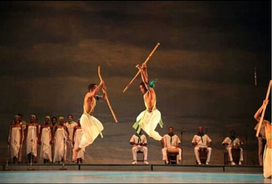Folk Dance
The folk dances of the Conjunto Folklórico Nacional draw from the Afro-Cuban culture including the religion of Santeria.
The religion of Santeria that is practiced in Cuba came from the Yoruba culture of Nigeria and was brought to the Caribbean with the slave trade. It is a religion believed to have been derived from nature, and aspects of nature such as fire, lightning, and wind are associated with deities called Orishas. Those who follow Santeria have an Orisha that they closely associate with and is meant to help them on their spiritual journey. Part of the connection with Orishas is made through music, song, and dance. These three elements are very closely entwined and can’t be separated from one another without losing some of the meaning behind the ritual. Orishas are usually personified by a dancer who may wear adornments associated with their chosen Orishas which also serves as a signal to the drummers, so they know what rhythm to play. Aside from specific adornments, there are rhythms and songs that are associated with each Orisha (Mansfield 2021; “Voices of the Orishas - Alexander Street, a ProQuest Company” n.d.). The objective of the dancer during these ritual dances is to channel the Orisha so that the energy spreads through their bodies and out into the rest of the world (Berry 2010).
Some Orishas include Elegua- which is characterized by a mischievous boy, Yemaya- a goddess of the sea, Chango- a figure of masculinity, and Oshun – a goddess of maternity, sweetness, and love (Mansfield 2021).
Watch the Conjunto Folklorico create a dance based on the Orisha Yemaya, or the goddess of the sea. In my research, every dance for Yemaya includes long blue skirts that are used in the dance. We can stipulate that the skirts and the movements created with them are meant to mimic the motion and energy of the sea. Video from the Conjunto Folklorico Nacional de Cuba you tube page (“Yemayá - YouTube” 2020).
This dance is dedicated to Elegguá. We can see the changes in the music and the movements of the dancers. There is a clear personality of the Orisha that is being conveyed. The style of dance is more youthful with lots of motions we associate with children playing (“Eshu - YouTube” 2020).
Images have been taken from the Conjunto Folklorico Nacional Facebook and Instagram page. You can follow and support them at Conjunto Folklorico Nacional on both platforms (“Facebook” n.d.; “Conjunto Folklórico Nac Cuba (@conjuntofolkloriconac) • Instagram Photos and Videos” n.d.).














